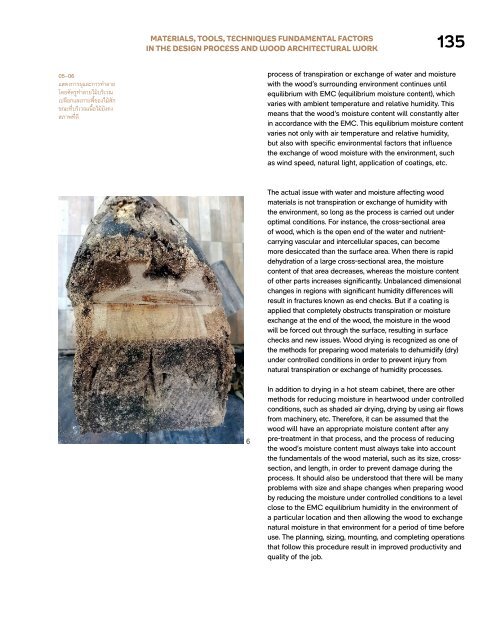ASA JOURNAL 14/2023
Create successful ePaper yourself
Turn your PDF publications into a flip-book with our unique Google optimized e-Paper software.
MATERIALS, TOOLS, TECHNIQUES FUNDAMENTAL FACTORS<br />
IN THE DESIGN PROCESS AND WOOD ARCHITECTURAL WORK<br />
135<br />
05-06<br />
แสดงการผุและการทำาลาย<br />
โดยศัตรูทำาลายไม้บริเวณ<br />
เปลือกและกระพี้ของไม้สัก<br />
ขณะที่บริเวณเนื้อไม้ยังคง<br />
สภาพที่ดี<br />
process of transpiration or exchange of water and moisture<br />
with the wood’s surrounding environment continues until<br />
equilibrium with EMC (equilibrium moisture content), which<br />
varies with ambient temperature and relative humidity. This<br />
means that the wood’s moisture content will constantly alter<br />
in accordance with the EMC. This equilibrium moisture content<br />
varies not only with air temperature and relative humidity,<br />
but also with specific environmental factors that influence<br />
the exchange of wood moisture with the environment, such<br />
as wind speed, natural light, application of coatings, etc.<br />
The actual issue with water and moisture affecting wood<br />
materials is not transpiration or exchange of humidity with<br />
the environment, so long as the process is carried out under<br />
optimal conditions. For instance, the cross-sectional area<br />
of wood, which is the open end of the water and nutrientcarrying<br />
vascular and intercellular spaces, can become<br />
more desiccated than the surface area. When there is rapid<br />
dehydration of a large cross-sectional area, the moisture<br />
content of that area decreases, whereas the moisture content<br />
of other parts increases significantly. Unbalanced dimensional<br />
changes in regions with significant humidity differences will<br />
result in fractures known as end checks. But if a coating is<br />
applied that completely obstructs transpiration or moisture<br />
exchange at the end of the wood, the moisture in the wood<br />
will be forced out through the surface, resulting in surface<br />
checks and new issues. Wood drying is recognized as one of<br />
the methods for preparing wood materials to dehumidify (dry)<br />
under controlled conditions in order to prevent injury from<br />
natural transpiration or exchange of humidity processes.<br />
6<br />
In addition to drying in a hot steam cabinet, there are other<br />
methods for reducing moisture in heartwood under controlled<br />
conditions, such as shaded air drying, drying by using air flows<br />
from machinery, etc. Therefore, it can be assumed that the<br />
wood will have an appropriate moisture content after any<br />
pre-treatment in that process, and the process of reducing<br />
the wood’s moisture content must always take into account<br />
the fundamentals of the wood material, such as its size, crosssection,<br />
and length, in order to prevent damage during the<br />
process. It should also be understood that there will be many<br />
problems with size and shape changes when preparing wood<br />
by reducing the moisture under controlled conditions to a level<br />
close to the EMC equilibrium humidity in the environment of<br />
a particular location and then allowing the wood to exchange<br />
natural moisture in that environment for a period of time before<br />
use. The planning, sizing, mounting, and completing operations<br />
that follow this procedure result in improved productivity and<br />
quality of the job.


















